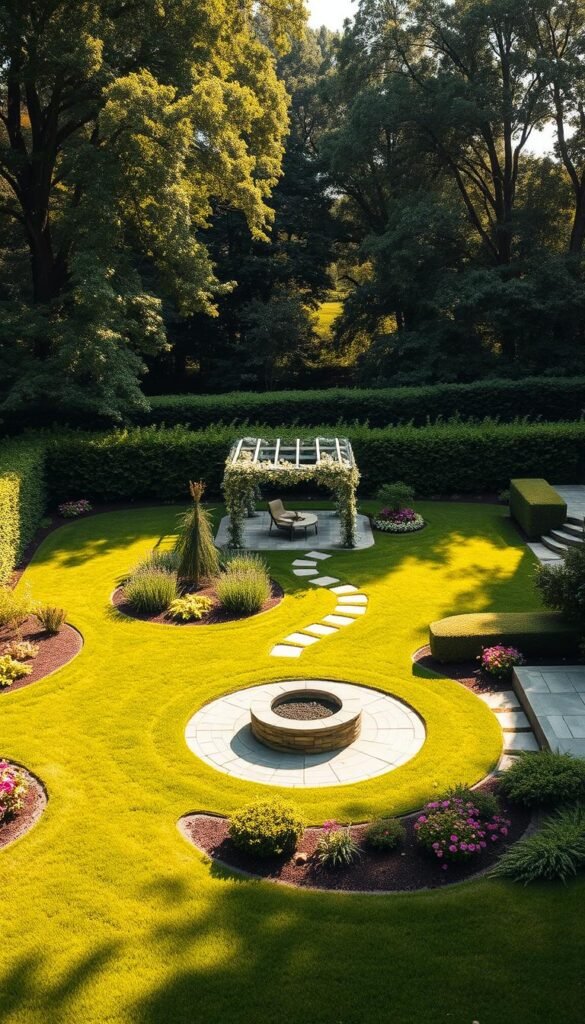Your outdoor area holds more potential than you might realize. With thoughtful planning, it can become a versatile sanctuary where laughter mingles with quiet moments of peace. Imagine hosting friends under string lights one evening, then sipping coffee surrounded by calming greenery the next morning.
Traditional zen principles offer inspiration, even if you’re not crafting a formal meditation space. Elements like smooth stones, flowing gravel patterns, and simple plants create visual harmony. These features encourage mindfulness while requiring minimal upkeep—perfect for busy lifestyles.
Studies show spending time in nature-rich environments lowers stress and boosts creativity. A well-planned layout balances social zones with cozy nooks, letting you recharge or connect with others effortlessly. The key lies in blending function with serenity.
Whether you have acres or a petite patio, smart solutions exist. We’ll explore how to maximize your square footage without sacrificing style. From durable seating to strategic plant choices, every detail contributes to an inviting atmosphere that adapts to your needs.
Planning Your Perfect Outdoor Space
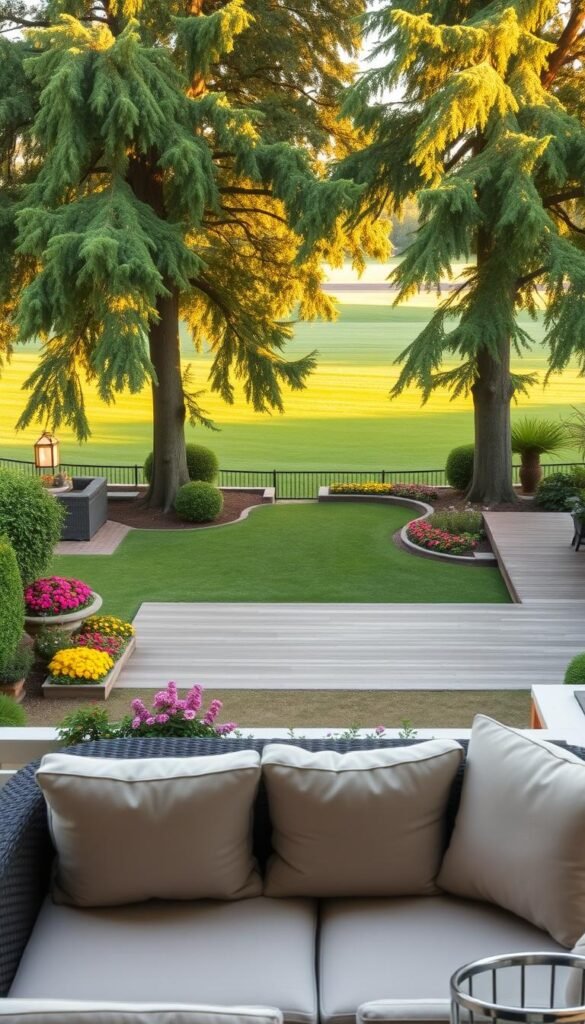
The foundation of a great outdoor area lies in understanding your space. Start by sketching a rough map of your yard’s dimensions. Note slopes, trees, and existing structures—these elements shape your possibilities. Sun patterns matter most: track where light hits during breakfast hours versus evening gatherings.
Assessing Your Backyard Layout
Measure twice, plant once. Use stakes and string to mark potential seating areas or garden beds. Check drainage by observing where water pools after rain. If adding a fire pit or water feature, test soil stability first. Rocky or clay-heavy ground might need extra prep work.
| Zone Type | Sun Exposure | Best For | Key Features |
|---|---|---|---|
| Dining | Partial shade | Meals & socializing | Level ground, near kitchen |
| Lounge | Morning sun | Reading/relaxing | Comfortable seating, side tables |
| Garden Beds | 6+ hours sun | Herbs/flowers | Rich soil, irrigation access |
Defining Your Entertaining and Relaxation Needs
How does your family use the yard? Frequent hosts might prioritize a large dining table, while book lovers crave secluded nooks. List must-haves: storage for cushions, space for kids to play, or room for a grill station. Fix pain points like uneven walkways or poor lighting early in the process.
Backyard Garden Design for Entertaining and Relaxation Ideas
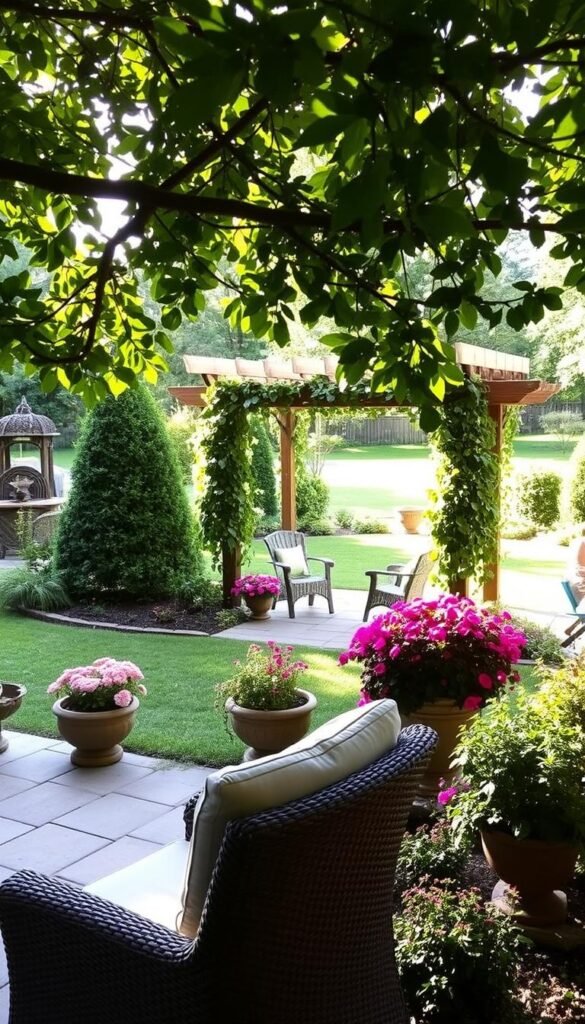
Turn everyday moments into memories with a thoughtfully curated outdoor escape. Start by dividing your area into flexible zones that serve multiple purposes. A sunlit breakfast spot could moonlight as an afternoon work nook, while raised planters might double as casual seating during gatherings.
Try these space-enhancing strategies:
- Use foldable benches that tuck under tables when not in use
- Position aromatic lavender near seating areas for dual sensory appeal
- Install removable shade sails above dining spaces
Natural materials like teak or rattan furniture create warmth, while gravel pathways visually separate zones without rigid barriers. Water features add soothing background noise—perfect for masking neighborhood sounds during both lively parties and solo meditation sessions.
Lighting plays a crucial role. Solar-powered string lights above conversation areas cast a welcoming glow, while recessed deck fixtures prevent tripping hazards. For cohesive styling, elevate your gardening aesthetic with matching planters or textured throw pillows that echo your indoor decor.
Remember: successful layouts balance practicality with personality. A fire pit surrounded by movable stools accommodates marshmallow roasts and sunrise yoga alike. Let your space evolve with your needs—that’s the mark of truly smart outdoor living.
Integrating Zen Gardens and Tranquil Water Features
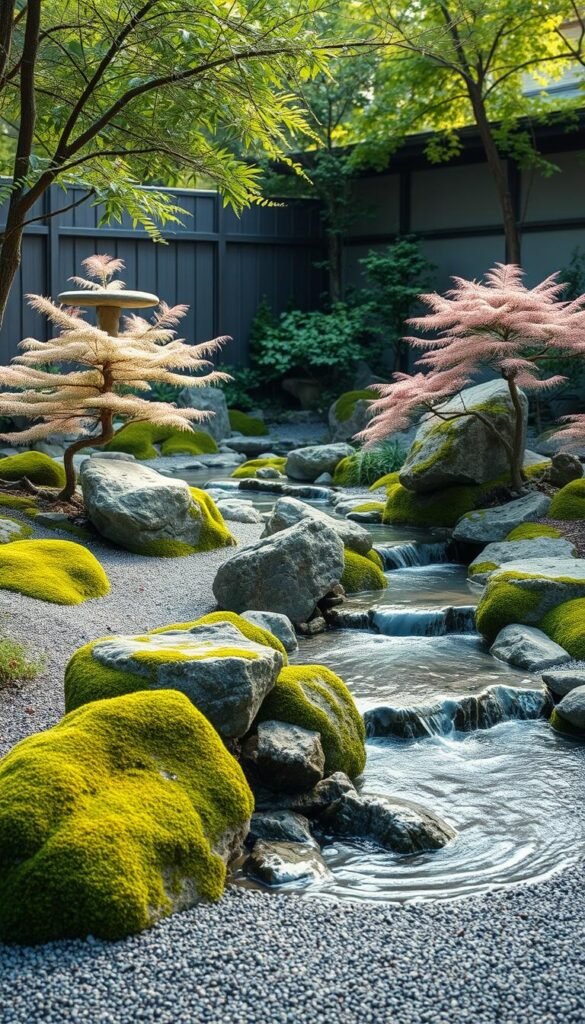
Transform your outdoor sanctuary into a haven of calm with elements that soothe the senses. Thoughtful combinations of natural textures and gentle movement foster an atmosphere where stress dissolves, whether you’re hosting friends or enjoying solitude.
Benefits of a Zen Garden Atmosphere
Zen-inspired spaces thrive on simplicity. Raked gravel mimics flowing rivers, while strategically placed stones anchor the design. These minimalist gardens require little upkeep but deliver maximum impact. Studies suggest such environments reduce heart rates by 15% within minutes of exposure.
Even small touches matter:
- Moss clusters between stepping stones soften pathways
- Bamboo screens filter sunlight while adding privacy
- Lanterns cast warm glows during evening reflection
Incorporating Water Elements for Serenity
Moving water brings life to any space. A tabletop fountain’s gentle trickle masks street noise, while koi ponds become living art. For those seeking low-maintenance options, recirculating water features like cascading urns offer visual interest without complex plumbing.
Consider these placement tips:
- Position ponds where reflections double your garden’s beauty
- Use shallow birdbaths to attract butterflies
- Install a wall-mounted spout near seating areas
Pairing water with soft lighting creates magical effects after dark. Explore how water features and fairy lights can elevate your evening ambiance. Remember: even modest additions like a stone basin can become focal points that invite pause and appreciation.
Selecting Low-Maintenance Plants and Garden Beds
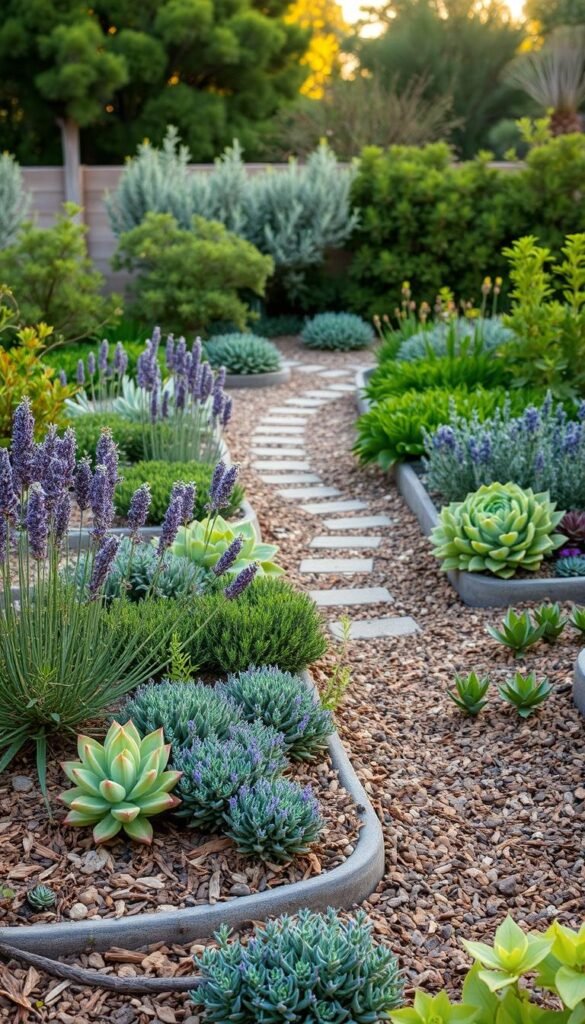
Smart plant choices transform upkeep into enjoyment while boosting your space’s natural charm. Begin by exploring species that thrive in your region’s conditions—these resilient selections become the backbone of your living landscape.
Choosing the Right Flora for Your Climate
Native species outperform imports every time. They’ve adapted to local rainfall patterns and soil types, meaning less watering and fertilizing for you. “These plants form partnerships with regional pollinators,” notes a University of Maryland study, “creating self-sustaining ecosystems in your yard.”
Try these winning combinations:
- Drought-tolerant sedum and lavender for sunny spots
- Ferns paired with wild ginger in shaded areas
- Ornamental grasses that sway gracefully in breeze
| Plant Type | Water Needs | Ideal Zones |
|---|---|---|
| Stonecrop | Low | 3-9 |
| Bee Balm | Medium | 4-9 |
| Blue Fescue | Low | 4-8 |
When arranging garden beds, leave space between rocks and plant bases. This prevents root overheating during summer scorchers. For small-space solutions, explore patio container gardening techniques that maximize impact with minimal effort.
Mix plants with staggered bloom times—early spring bulbs followed by summer-blooming coneflowers. This strategy keeps your low maintenance beds lively for months without constant replanting. Remember: right plant, right place equals more relaxation time for you.
Designing Inviting Outdoor Living and Entertainment Areas
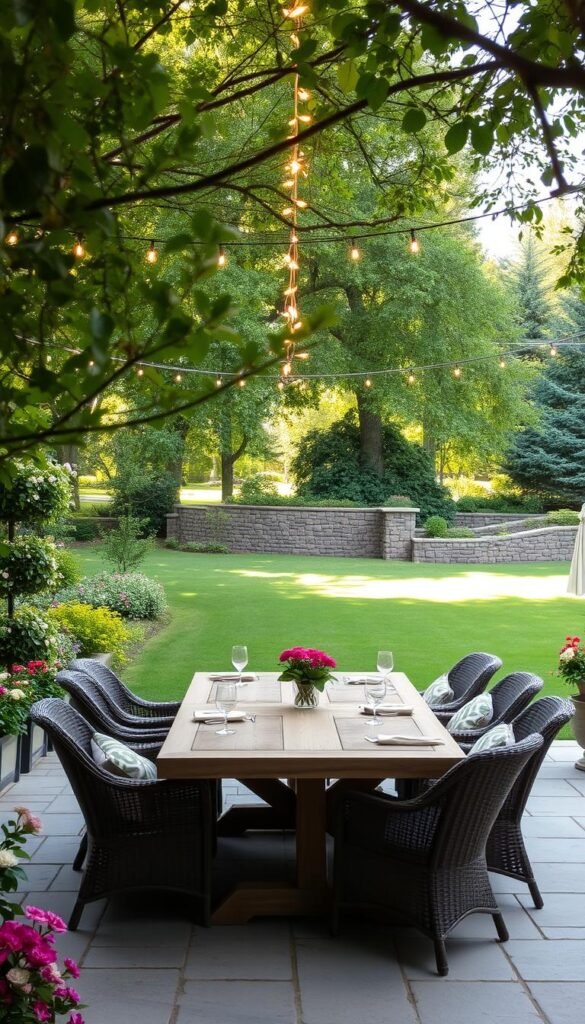
Crafting a cozy environment starts with smart layout choices and comfortable furnishings. Your outdoor living space should blend relaxation with practicality, becoming a natural extension of your home. Focus on arrangements that encourage connection while offering flexibility for different occasions.
Creating Comfortable Seating Arrangements
Prioritize modular pieces like sectional sofas or stackable chairs. These allow you to effortlessly adapt your setup for large groups or solo relaxation. Weather-resistant fabrics in neutral tones create a timeless base—add pops of color with accent pillows that withstand sun exposure.
Arrange seating to face focal points like fire pits or garden views. Include side tables within arm’s reach for drinks and snacks. For smaller areas, built-in benches with hidden storage maximize functionality without clutter.
Establishing a Functional Dining Zone
Position your dining area near indoor kitchens for easy meal transitions. Choose tables with durable surfaces like powder-coated metal or teak—materials that handle spills and weather shifts. Overhead string lights or pendant fixtures set the mood while illuminating dishes.
Consider these elements for successful setups:
- Allow 30” between chairs for comfortable movement
- Use outdoor rugs to define the space visually
- Incorporate bench seating to accommodate extra guests
Scale furniture to match your space: compact bistro sets suit intimate patios, while extendable tables shine in larger zones. A well-planned living space makes every gathering feel effortless, from brunches to starlit dinners.
Innovative Use of Containers and Vertical Gardens
Unlock hidden potential in your outdoor oasis with movable greenery and sky-high plant displays. Containers let you reimagine layouts weekly or seasonally—swap vibrant petunias for mums when autumn arrives, or shift potted palms to create instant shade during summer gatherings.
Maximizing Space with Container Gardening
Perfect for renters or design enthusiasts, these portable ecosystems require no permanent changes. Arrange ceramic pots to separate conversation nooks from dining zones, or use tiered plant stands to add depth to narrow balconies. Vertical solutions like wall pockets or hanging baskets free up floor space while drawing eyes upward.
Try these adaptable options:
- Herb towers near seating areas for fresh garnishes
- Climbing jasmine on trellises to soften fences
- Stackable planters with trailing ivy for privacy screens
Material choices impact both style and plant health. Glazed ceramic retains moisture for thirsty flowers, while breathable terra cotta suits succulents. For modern flair, try geometric steel planters paired with ornamental grasses. Discover colorful container gardening ideas that thrive in your region’s climate.
Rotate sun-loving species to south-facing walls and shade-tolerant ferns beneath trees. This strategic placement ensures every plant thrives, letting you enjoy lush greenery with minimal effort.
Incorporating Strategic Lighting and Fire Pit Features
Evening transforms your space into a new realm of possibilities. Thoughtful illumination paired with flickering flames turns ordinary nights into memorable experiences. Start by mapping where lighting matters most—pathways for safety, seating areas for warmth, and focal points for visual drama.
Choosing Warm, Soft Lighting Options
Soft glows invite relaxation better than harsh beams. Dimmable LED string lights above seating zones let you adjust brightness for dinners or stargazing. Solar-powered path markers with amber tones guide feet while maintaining a cozy atmosphere.
| Lighting Type | Best For | Key Features |
|---|---|---|
| String Lights | Overhead Ambiance | Weather-resistant, adjustable length |
| Solar Path Lights | Walkway Safety | Automatic dusk-to-dawn operation |
| LED Spotlights | Architectural Highlights | Energy-efficient, directional focus |
Enhancing Ambiance with a Fire Pit
A fire pit becomes the heart of evening gatherings. Choose portable propane models for flexibility or permanent stone builds for rustic charm. Position seating 24-36″ from flames for warmth without smoke irritation.
Safety first:
- Keep 10-foot clearance from structures
- Use spark screens with wood-burning units
- Store firewood upwind of flames
This addition extends outdoor enjoyment through cooler months. Pair crackling logs with hot cocoa or summer s’mores—your fire pit adapts to every season’s vibe.
Budget-Friendly DIY Upgrades for Your Backyard
Revamping your outdoor space doesn’t need to drain your wallet—clever tweaks can yield stunning results. Start by hunting for materials at local reuse centers or online marketplaces. One homeowner transformed an old ladder into a vertical herb planter, proving imagination beats budget every time.
Focus on high-impact, low-cost ideas first. A fresh coat of weatherproof paint breathes new life into worn furniture. Stack cinder blocks to create instant side tables, or arrange thrifted terracotta pots as stepping stones. These additions deliver visual punch without permanent changes.
| Material Source | Average Cost | Best For |
|---|---|---|
| Habitat ReStore | $5-$50 | Pavers, lumber |
| Facebook Marketplace | Free-$20 | Planters, furniture |
| Local Nurseries | $3-$15 | End-of-season plants |
Propagate plants from cuttings to fill empty beds for free. Mint and rosemary root easily in water, while succulents grow from single leaves. “The best home upgrades come from working with what you have,” notes DIY enthusiast Lara Simmons. She turned broken tiles into a mosaic fire pit surround using $12 worth of mortar.
Time purchases strategically:
- Shop patio furniture in late August
- Buy soil amendments during spring sales
- Stock up on seeds post-holiday
Even small options like hanging tea lights in mason jars create ambiance. Build your oasis gradually—each project adds character while keeping costs manageable.
Privacy Solutions and Defined Garden Zones
Creating intimate retreats in your yard starts with smart privacy strategies. Tall grasses or flowering hedges form natural screens, while ivy-covered trellises add vertical greenery. These solutions blend seamlessly into your landscape, offering seclusion without sacrificing style.
Define distinct zones using crushed shells or clover ground covers. A winding pathway lined with solar lanterns guides visitors while marking transitions between areas. For cottagecore charm, try repurposing vintage items like iron frames as plant supports—cottagecore aesthetic touches elevate practicality into whimsy.
Layer seating with weathered benches and linen cushions to make spaces feel intentional. Wind chimes or string lights enhance ambiance while maintaining an airy feel. With thoughtful planning, your yard becomes a collection of purposeful nooks—each designed for moments of quiet joy.

